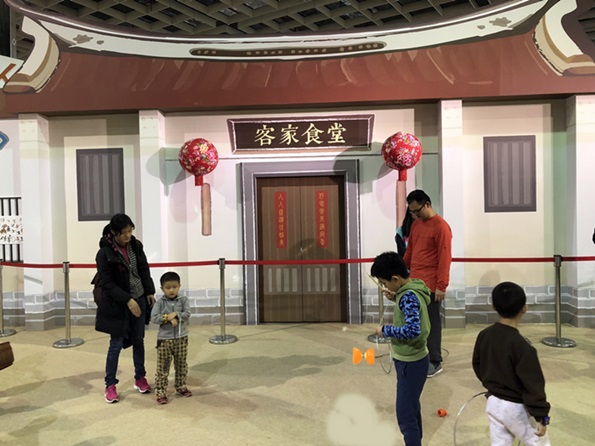To promote Hakka culture, Taiwan’s Hakka Affairs Council (客家委員會) has organized the Hakka Expos in Taipei once every two years. This year’s event was held at the Taipei World Trade Center Nangang Exhibition Hall from December 2-10, 2017 and attracted some 350,000 visitors.
Please watch the following video of the 2017 Hakka Expo in Taipei, Taiwan:
At the opening ceremony, a Hakka song specially composed for the Expo was performed by famous Hakka singer UrbanCat (二本貓) and Hakka athlete Zheng Zhaocun (鄭兆村), who won the gold medal in the men’s javelin and broke the Asian record at the 2017 Taipei Summer Universiade.

The 2017 Hakka Expo features the beauty of Hakka villages and the harmony between the Hakka people and the environment. (Image: Billy Shyu via Nspirement)

A barn made of straw and traditional tools used in Hakka villages at the Hakka Expo. (Image: Julia Fu via Nspirement)
Emphasizing the spirit of harmony between the people and the land, the theme of this Hakka Expo was “靚庄” (Jing Zhuang), which literally translates into 靚 (Jing), “pretty or beautiful,” and 庄, meaning “village.” The Expo showcased the relationship between Hakka people and the land to further heighten awareness of our environment. It also emphasized the beauty of Hakka villages and the distinctive products they produce, while promoting Hakka culture and cuisine.
The Expo shared the unique Hakka culture
There were six different areas in the Expo, and each highlighted various aspects of Hakka culture and lifestyle. A total of 100 firms were invited to showcase their Hakka agricultural products, artwork, handicrafts, textiles, and food. Visitors could gain insights into Hakka culture, while also purchasing a wide variety of Hakka souvenirs, cultural and creative products, and cuisine.
One popular attraction for many adults and children was the rice-drying ground exhibit, where family members could play traditional Hakka games, diabolo (扯鈴), and other participate in other activities.
Among the artworks that intrigued visitors were the unique bottle gourd carvings, lacquerware, oil-paper umbrellas, clay modeling works, and blue dye works. The Hakka cuisine that was especially liked by visitors included Hakka rice cakes (Mochi 麻糬), Hakka tea, crystallized fruit, sticky rice dumplings, and dried persimmons (柿餅).
The Hakka Affairs Council said that the Expo did much to help promote the distinctive Hakka culture and enhance the general public’s understanding of the development of Hakka industries.

Traditional Hakka oil-paper umbrellas on exhibit at the 2017 Hakka Expo in Taipei. (Image: Julia Fu via Nspirement)
Representing 19.3 percent of Taiwan’s population, the Hakka population is 4.54 million, and they are the nation’s largest minority group after the Hoklo people. To revitalize the Hakka language and culture, and to promote Hakka cultural research and exchange, the Hakka Affairs Council, a cabinet-level agency under the Executive Yuan, was established on June 14, 2001.
In addition to holding Hakka expos, the Hakka Affairs Council also sponsors a variety of Hakka cultural and educational activities year round. Moreover, Hakka cultural parks and museums have been established in various cities and counties across Taiwan, including Taipei City Hakka Cultural Park, Taoyuan Hakka Cultural Hall, Liudui Hakka Cultural Park, and Miaoli Park.
In an effort to revive the Hakka language, the Hakka Affairs Council also holds regular Hakka language proficiency tests. The tests are divided into elementary, intermediate, intermediate-advanced, and advanced levels, and those who pass the tests are awarded certificates.

A variety of traditional Hakka rice cakes are available at the Hakka Expo. (Image: Billy Shyu via Nspirement)
Follow us on Twitter, Facebook, or Pinterest







